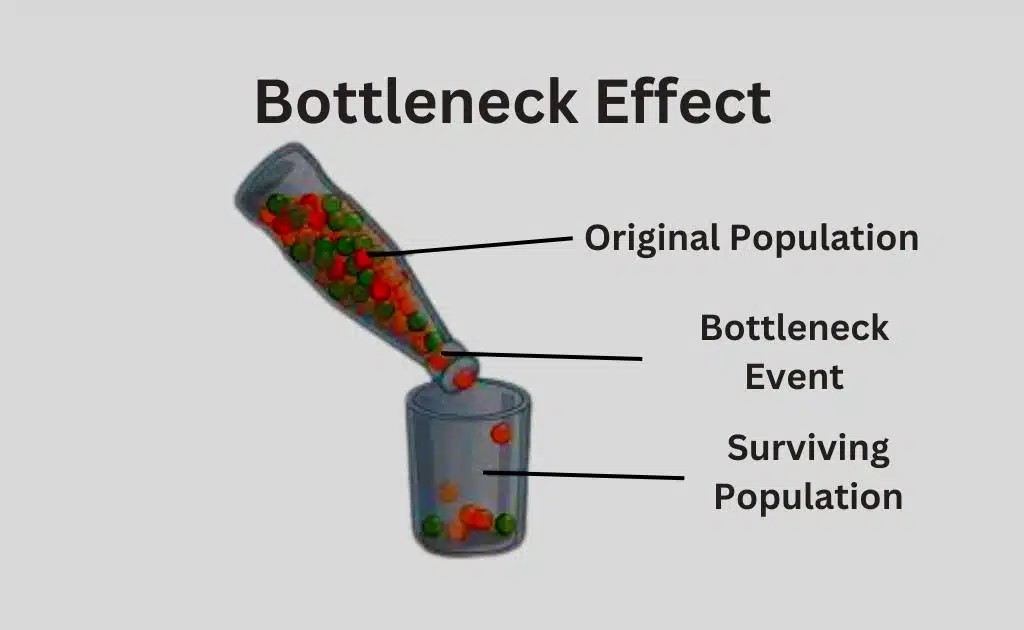What Is Genetic Drift?-Definition, Cases, and Examples | Founder Effect | Bottleneck Effect
Genetic drift refers to the random shift in gene frequencies. A gene‘s persistence in a population is significantly influenced by chance. In a smaller population, the chance is more important. it encourages reproduction.
Some population characteristics do not endure. However, they enter the gametes accidentally during fertilization. The frequency of genes in populations is affected by random events. The result is genetic drift. Neutral selection is the term used to describe genetic drift.
Genetic Drift
Genetic drift is a change brought on by “sampling error” while choosing the alleles from the gene pool of the current generation. Even though genetic drift occurs in all groups, its effects are frequently more dominant in small populations.
Flipping a thin coin is comparable to the process of genetic drift. Either the head or the tail can be expected. In a large number of tosses, the odds of getting heads or tails are approximately exactly 50:50. In just 10 throws, the ratios are out of balance.
7 heads and 3 tails could be the ratio. There are two equally adapted alleles, too. Unexpectedly, a gamete will contain one of these two alleles. As a result, a second generation receives it. Therefore, the odds for both alleles are equal.
But in a small population, like flipping a coin, meiosis results in very high levels of alleles in gametes. Assume that both alleles are equally fit. These random occurrences may alter the frequency of a specific condition.
Additionally characteristic of tiny groups is inbreeding. Genetic diversity within a population is decreased via inbreeding and genetic drift.
Example of Genetic Drift
Let’s say a population experiences a mutation that adds a new allele. Compared to current alleles, the allele is less adaptable. The emergence of the novel allele in the population may be aided by genetic drift. Or the new allele can disappear as a result of genetic drift. As a result, Hardy-Weinberg equilibrium does not exist in tiny populations due to genetic drift.
Special Cases Of Genetic Drift
Two special cases of genetic drift influenced the genetic makeup of some populations. These are:
Founder Effect
The founder effect is the name of genetic drift in a young colony. For instance, a small number of members of a parental population establish new habitats. They do not inherit their parent population’s whole gene pool.
New colonies are established by the founders. Its genetic makeup is peculiar F1 9 in nature. In comparison to the larger population, it is much less variable. The founder effect is the name given to this type of genetic drift.

Example Of Founder Effect
The eastern Pennsylvanian tribe known as the Dunkers is a prime example of the founder effect. They arrived in America from Germany around the beginning of the eighteenth century. Because of their religious beliefs, they did not wed people from other sects. specific characteristics, such as
It demonstrates that their gene frequencies are considerably different from those of the German Dunker populations. It is thought that some genes were lost from the original members of the Pennsylvania Dunker group due to genetic drift or accident. As a result, the Dunkers’ subsequent generations have different gene frequencies from the German Dunkers.
Bottleneck Effect
Genetic drift in a population that has been drastically reduced by disasters is called the bottleneck effect.

Examples Of The Bottleneck Effect
Cheetah populations in South and East Africa are endangered. Their depleted populations have reduced genetic diversity. If their population is restored, they have only a remnant of the original population’s gene pool. It occurs due to the bottleneck effect.
Another illustration of the bottle effect is the northern elephant seal. In the late 1800s, they were nearly exterminated by hunting. In 1922, legislation was passed to safeguard the seal. Now there are more than 100,000 people living there. However, the population has little genetic variation.
Effects Of Bottlenecks
The conventional view is that bottleneck impact reduces population genetic diversity. Environmental stress cannot be tolerated by this group. Consequently, they go extinct. People in a group with a lot of genetic variants have mixed genes.
They can survive environmental changes thanks to these genes. There is a lot of genetic variation within the cheetah population, according to recent studies. But cheetah cubs are preyed upon by lions and spotted hyenas.
As a result, they are going extinct. The majority of evolutionary biologists do concur that significant genetic variety and long evolutionary time scales lessen the likelihood of extinction.
Research in Field of Genetic Drift
- The pseudo hitchhiking model developed by scientists approximates the effects of selected substitutions on a closely linked neutral locus, leading to stochastic dynamics that resemble genetic drift. As genetic draft induced by linked selection can be a more significant stochastic force than this, this model provides insight into the relative importance of these forces in shaping neutral allele frequencies and resolving paradoxes in population genetics. [1]
- Scientists have studied the evolution of mutation rates and proposed the drift-barrier hypothesis, which suggests that natural selection primarily operates to improve DNA replication fidelity, but the ultimate limits to this improvement are determined by the power of random genetic drift. Through comparative measures of mutation rates, they have shown that error-prone polymerases exist as a trade-off between replication fidelity and evolutionary potential. This research highlights the importance of understanding the evolution of mutation rates in all areas of Biology. [2]






Leave a Reply